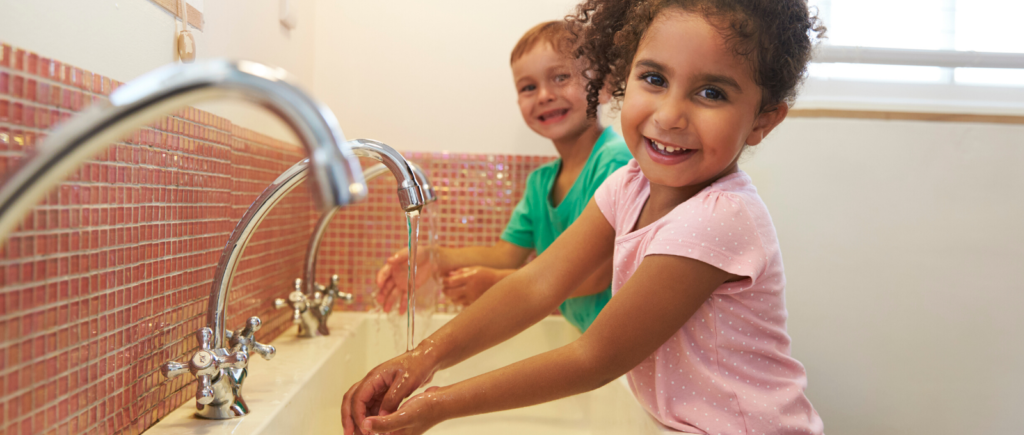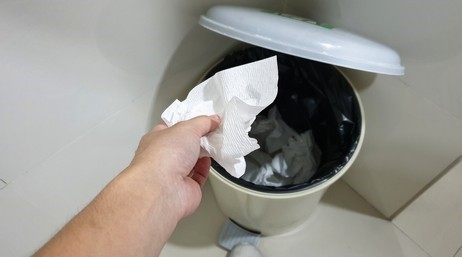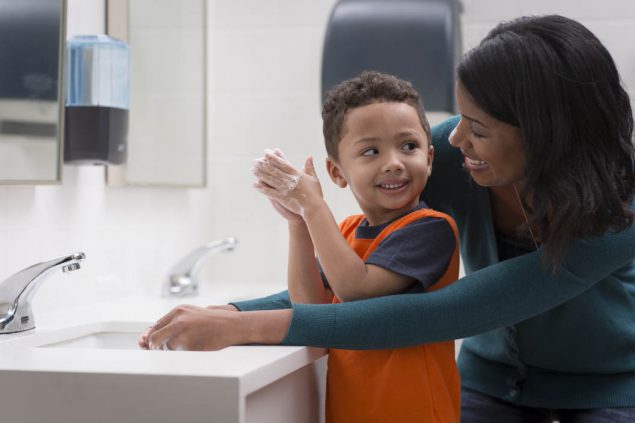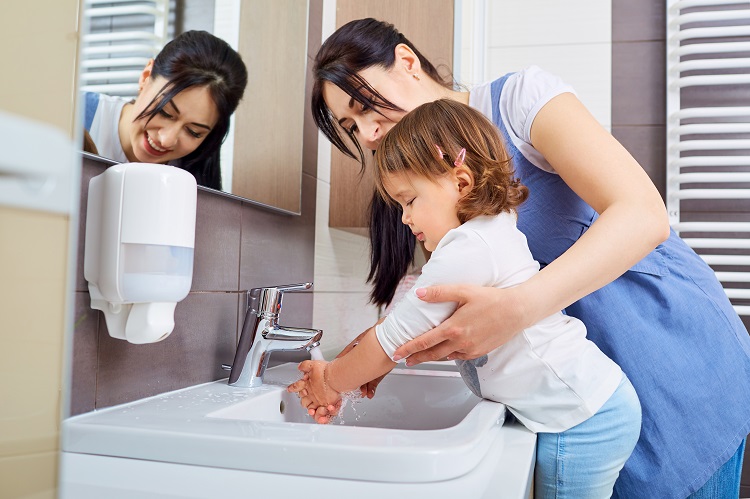Handwashing
Personal hygiene plays an essential role in children’s physical health. Activities that foster hygiene help reinforce the immune system, which is immature during the first years of life.

Handwashing is the single best means of preventing infections from bacteria, viruses, and parasites. People and objects can directly or indirectly transmit these microorganisms. Epidemiological research has shown that hands are the primary source of transmission of infections. Handwashing needs to be taken seriously because it reduces these risks by up to 50 percent. Moreover, handwashing is a concrete way to foster children’s wellbeing by decreasing diseases caused by contamination.
Effective handwashing is a health habit children need for the rest of their lives. Early childhood educators have to pay special attention to the handwashing of young children whose immune systems are still immature.
Materials and Equipment
Sinks should be at a child’s height and located where children take their meals. Another option is to install sinks at regular height and use moveable antiskid steps for children. This option has the advantage of sparing the educator’s back. Another point to consider is the use o separate sinks for handwashing, food handling, and toilet routines. A sink with a handless faucet or a single faucet is more accessible for children to use.

Liquid soap in a dispenser that you can hold is more accessible in a classroom with multiple sinks and little hands. Those on a wall can be difficult for little hands and cause more work for the teacher. The use of germicidal soap should be avoided as much as possible because of its irritating effects. Such soap also contributes to the increased resistance of bacteria.
Hands should be dried with a disposable paper towel to avoid contamination. Cloth towels can transmit germs from one person to another. Electric hand dryers are not recommended because they take longer to dry hands, break easily, and are known to add germs to clean hands. Only in exceptional situations should sanitizing hand solution without a rinse or wipe should be used. These products are more expensive and can be harmful to the child.
A garbage can lined with a plastic bag must be placed next to each sink to dispose of used paper towels to discourage young children from throwing them in the toilet. Ideally, a lidded step can be used to avoid hand contact with the cover. Garbage can covers are heavily contaminated by wastes such as food, dirty diapers, and soiled paper towels. All garbage cans indoors and out must be sanitized regularly.

A garbage can lined with a plastic bag must be placed next to each sink to dispose of used paper towels to discourage young children from throwing them in the toilet. Ideally, a lidded step can be used to avoid hand contact with the cover. Garbage can covers are heavily contaminated by wastes such as food, dirty diapers, and soiled paper towels. All garbage cans indoors and out must be sanitized regularly.
When to Wash Hands
Appropriate hand washing with warm water and soap is not enough. It also has to be done at the right time to maximize its efficiency. Educators, as well as children, should follow these rules.
NAEYC sets the following hand washing practices for their health standards.
Handwashing Standards:
- Staff members and those children who are developmentally able to learn personal hygiene are taught handwashing procedures and are periodically monitored.
- Handwashing is required by all staff, volunteers, and children when handwashing would reduce the risk of transmission of infectious diseases to themselves and others.
- Staff assists children with handwashing as needed to complete the task successfully. Children wash either independently or with staff assistance.
Children and adults wash their hands:

- on arrival for the day
- after diapering or using the toilet
- after handling body fluids (ex: blowing noeses, coughing on a hand, or touching any mucus, blood, or vomit)
- Before and after meals and snacks, before preparing or serving food, or after handling any raw food that requires cooking.
- After playing in water that two or more people share.
- After handling pets and other animals or any materials such as sand, dirt, or surfaces that might be contaminated by contact with animals; and
- when moving from one group to another, that involves contact with infants and toddlers/ twos.
Adults also wash their hands:
- Before and after feeding a child
- before and after administering medication
- after assisting a child with toileting; and
- after handling garbage or cleaning.
Proper handwashing procedures are followed by adults and children and include:

- using liquid soap and running water
- rubbing hands vigorously for 20 seconds, including the back of hands, wrists, between fingers, under and around any jewelry, and under fingernails;
- rinsing well;
- drying hands with a paper towel, a single-use towel, or a dryer; and
- avoiding touching the faucet with just-washed hands.
Except when handling blood or body fluids that might contain blood (when wearing gloves is required), wearing gloves is an optional supplement but not a substitute, for handwashing in any required handwashing situation listed above.

- Staff wears gloves when contamination with blood may occur.
- Staff does not use handwashing sinks for bathing children or for removing smeared fecal material.
- In situations where sinks are used for both food preparation and other purposes, staff clean and sanitize the sinks before using them to prepare food.
Note: The use of alcohol-based hand rubs in lieu of handwashing is not recommended for early education and child care settings. If these products are used as a temporary measure, a sufficient amount must be used to keep hands wet for 15 seconds. Since the alcohol-based hand rub is toxic and flammable, it must be stored and used according to the state’s instructions.
Handwashing Technique
There is more to hand washing than using soap and water. Here are a few tips to maximize the best handwashing procedures.
- Remove rings, watches, and bracelets.
- Turn sleeves up to bare the forearms.
- Open the faucet to get warm water. To conserve water, don’t turn the water up all the way.
- Wetting hands before applying soap reduces skin dryness.
- Squirt a small amount of soap in the hand.
- Rub hands for at least 20 seconds. Remember to include the palm and back of hands, fingertips, spaces between the fingers, and wrists.
- Rinse well by rubbing hands under running water.
- Dry hands with a disposable paper towel.
- Close faucet with the used paper towel.
- Throw the paper towel in the garbage can without touching the can with your hands.
Time used for washing hands is time well spent because it minimizes the risk of disease.
Setting a Good Example
It is essential for the educator to wash her hands in front of the children to set a good example. This should be done after using the toilet, before and after touching food, after helping blow a nose, after changing a diaper, and after touching soiled objects or cleaning products. Children learn by observing adults, especially significant adults. They more readily accept the need to do certain things when consistent with an adult’s actions. Stress that you also wash your hands and that this is a good habit.
Handwashing Training

Good handwashing technique fosters the development of fine motor skills, hand coordination, body image, and memory in children. It also teaches children to take care of their health. Around fifteen to eighteen months, toddlers are usually ready to learn about washing their hands at the sink. However, it is not until the age of four that children can finally wash their hands efficiently. Before that, regular reminders and close supervision will be necessary to show them how to lather their hands all over and so forth.
Remind children why handwashing is so important. Simple explanations are the best. Some children may even enjoy spending time playing with soap and water. If necessary, redirect children’s attention. A well-placed poster about washing hands shown at a child’s level will reinforce the importance of handwashing. You may also introduce creative ideas to encourage children to take care of themselves.
Games
Handwashing is done about ten times a day, for a total of two thousand times a year for each child in a child care setting. To break the monotony of this activity, educators can organize games to introduce variety into this routine.
Indeed, with good planning, positive attitudes, a few simple ideas, and a little fun, hand washing can become quite interesting. Games allow children to associate pleasure with routine actions and minimize negative interventions by educators.
Suggestions to motivate children to wash their hands
- With toddlers, talk with them about what they are doing as they are doing it, making comments like, “The water is warm.”
- Go to the sink using an unusual walk: small steps like a mouse, walking on your heels, walking on tiptoes, and so forth. Use the theme of the moment and the children’s interest to get ideas.
- Go to the sink with an added challenge: Walk with hands-on heads, along an imaginary line, on a line drawn with masking tape, or around a chair.
- Draw out of a box or a hat the next child’s name to wash hands, or call a child according to a specific characteristic.
- Once in a while, initiate a conversation among children about hygiene to introduce the idea of taking care of their bodies. A book on the subject may introduce the discussion.
- Organize a relay game to get to the sink, having the children exchange an object or a password.
- Use a puppet to supervise handwashing and to remind the children of the rules.
- Try a fruity soap if there are no allergies to it. Children especially like fruity fragrances such as green apple, strawberry, mandarin, or grape.
- Give children some special “Clean Hand Boxes.” These boxes can be used only with clean hands. They contain several types of objects: small puzzles, little figures, paper and pencil, mittens, and so forth.
Songs

Even though the skill of washing hands and signing simultaneously is perfected only around the age of five or six, younger children are motivated by hearing songs and nursery rhymes about what to do. These songs also remind them of the handwashing steps and actions. Popular children’s songs can be modified to include words about handwashing.
